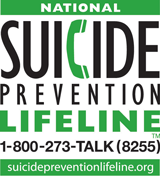Error processing SSI file
Suicide: Consequences
Suicide and Suicide Attempts Take an Enormous Toll on Society
- Suicide is the 10th leading cause of death among Americans.1
- More than 44,000 people died by suicide in 2015.1
- More than 1.4 million people reported making a suicide attempt in the past year.2
- Almost 10 million adults reported thinking about suicide in the past year.2
- Most people who engage in suicidal behavior never seek mental health services.2
Costs to Society
The following estimates are based on 2015 CDC data and refer to people age 10 and over.2
- Suicide costs society over $56.9 billion a year in combined medical and work loss costs.
- The average suicide costs $1,287,534.
Survivors
- A survivor of suicide is a family member or friend of a person who died by suicide.
- Surviving the loss of loved one to suicide is a risk factor for suicide.3
- Surviving family members and close friends are deeply impacted by each suicide and experience a range of complex grief reactions including, guilt, anger, abandonment, denial, helplessness, and shock.4,5
- No exact figure exists, but it is estimated that a median of between 6 and 32 survivors exist for each suicide, depending on the definition used.6
- According to another estimate, approximately 7% of the U.S. population knew someone who died by suicide during the past 12 months.7
References
- Centers for Disease Control and Prevention. Web-based Injury Statistics Query and Reporting System (WISQARS). Atlanta, GA: National Center for Injury Prevention and Control. Available at https://www.cdc.gov/injury/wisqars/leading_causes_death.html. Last updated January 2017.
- Substance Abuse and Mental Health Services Administration, Center for Behavioral Health Statistics and Quality, National Survey on Drug Use and Health, 2014 and 2015. https://www.samhsa.gov/data/sites/default/files/NSDUH-DetTabs-2015/NSDUH-DetTabs-2015/NSDUH-DetTabs-2015.pdf.
- Centers for Disease Control and Prevention. Cost of Injury Reports 2010. Available online at https://wisqars.cdc.gov:8080/costT/. Last updated January 2017.
- Brent D. What family studies teach us about suicidal behavior: implications for research, treatment, and prevention. Eur Psychiatry 25(5):260–263.
- Jordan J. Is suicide bereavement different? A reassessment of the literature. Suicide and Life-Threatening Behavior. 31(1): 91–102.
- American Association for Suicidology. Surviving after suicide factsheet. Available online: http://www.suicidology.org/Portals/14/docs/Resources/FactSheets/SurvivingAfterSuicide.pdf
- Berman, AL. Estimating the population of survivors of suicide: Seeking an evidence base. Suicide and Life-Threatening Behavior 2011. 41(1), 110–116.
- Crosby AE, Sacks JJ. Exposure to suicide: Incidence and association with suicidal ideation and behavior – United States, 1994. Suicide and Life-Threatening Behavior 32:321–328.
Need Help? Know Someone Who Does?
 Contact the National Suicide Prevention Lifeline
Contact the National Suicide Prevention Lifeline
- Call 1-800-273-TALK (1-800-273-8255)
- Use the online Lifeline Crisis Chat.
Both are free and confidential. You’ll be connected to a skilled, trained counselor in your area.
For more information, visit the National Suicide Prevention Lifeline.
- Page last reviewed: February 3, 2017
- Page last updated: February 3, 2017
- Content Source:


 ShareCompartir
ShareCompartir
